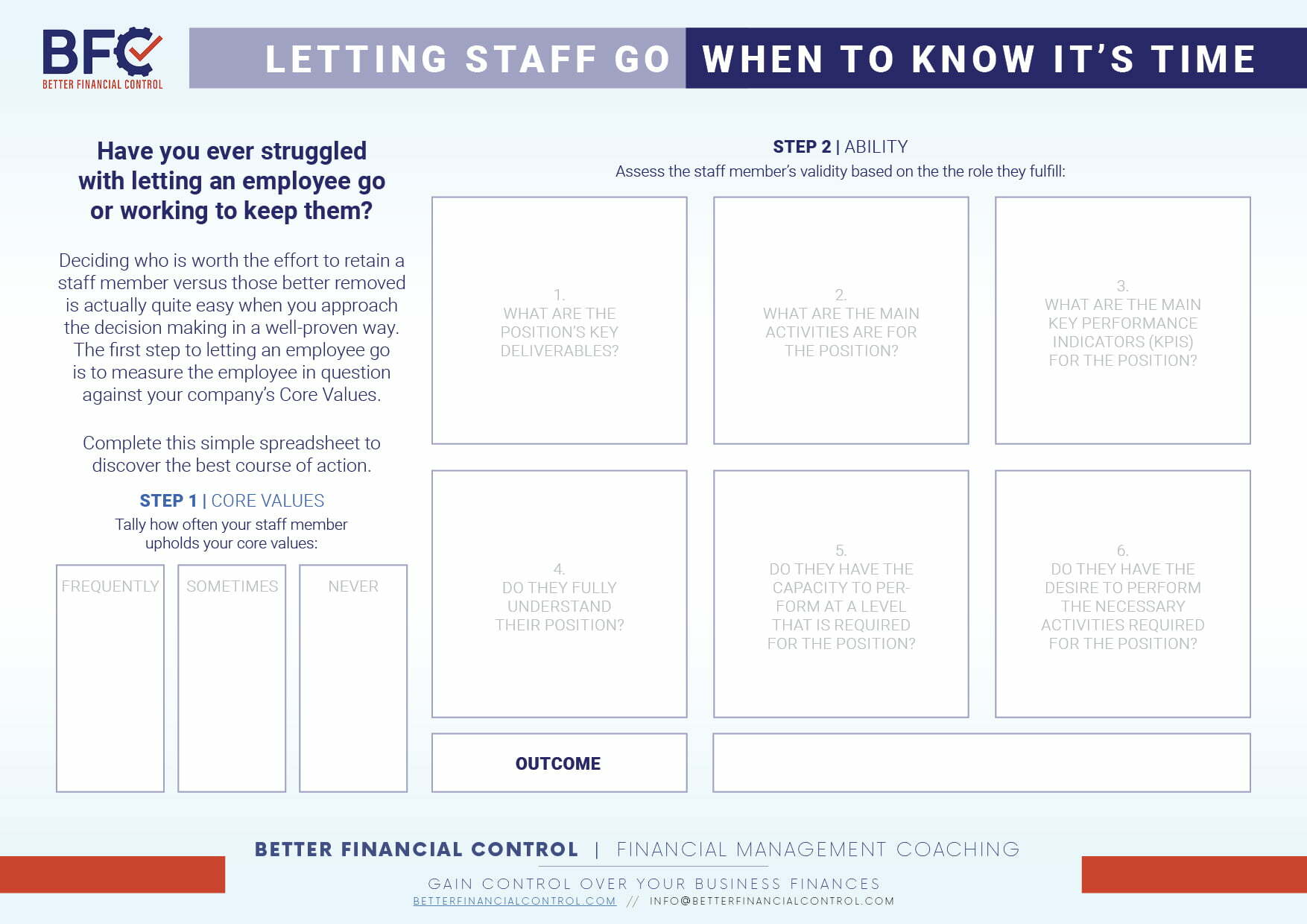Have you ever struggled with letting an employee go or working to keep them?
You might spend hours, days or even weeks in emotional discussions with business leaders trying to understand how to get various employees to acceptable levels of performance, but to no avail. This article focuses on providing a clear framework to diagnose whether you have an opportunity to fix a less than ideal employee performance situation or whether more drastic measures are needed.
With the current employee shortage it is always tempting to retain every employee possible rather than letting an employee go. However, the retention of one weak link can cause ramifications that may become detrimental to the entire team or business. Thus, it is always better to remove these weaker links because the cost of retention will always be higher than the modest void an exited employee will create in the short term.
Step 1 for Letting an Employee Go – Core Values
Deciding who is worth the effort to retain versus those better removed is actually quite easy when you approach the decision making in a well-proven way. The first step to letting an employee go is to measure the employee in question against your company’s Core Values.
This will be difficult if you have not developed well-established core values to promote and demote team members. But thankfully it is never too late to start. If you understand the necessity of Core Values and how they work within organisations but you have yet to implement this strategy into your company, put this article aside and spend the time necessary to implement them effectively. You will be grateful you did and it will always be time well spent for long-term gain.
If you have identified your company’s Core Values then ask yourself how frequently you observe the employee in question embodying them using a criteria of Frequently, Sometimes or Never. For an employee to align with your organisation there shouldn’t be any Nevers, with a mix of Sometimes and Frequently. It can be personally confronting to exit your first employee using Core Values as a decision-making process but when you see the impact on the rest of the remaining team you will realise that your decision of letting an employee go was wholly justified.
Step 2 for Letting an Employee Go – Ability
After you determine whether the employee in question aligns with your Core Values, the next step is to identify whether they have the ability to deliver what is required in their position or seat. In order to do this both objectively and effectively, it is important to have the employee’s position or role well defined. For this, three things should be addressed:
- What are the position’s key deliverables? This explains ‘why’ this position exists and how you know it is being done well.
- What are the main activities are for the position? This should provide insights into what the person does for much of their time.
- What are the main Key Performance Indicators (KPIs) for the position? This will avoid any doubt in what the expected level of activity and performance needs to be within the role.
With this review of the employee’s position in hand you are now ready to evaluate your employee by asking yourself three questions:
- Do they fully Understand their position? Often times there can be a fundamental misunderstanding regarding what is important about a position versus what is simply ‘nice to have.’ When you have a clearly-defined role as described above this is less likely, but most businesses don’t do a great job of defining in writing what is critical about a role – the position’s key deliverables. If you have any doubt whether they fully understand the position you need to invest some time in ensuring this is not the issue.
- Do they have the Capacity to perform at a level that is required for the position? Although one could use sophisticated cognitive assessments to determine this for some roles, typically you as a business leader can often get a good impression simply by asking yourself this question. By answering yes to Question One you know they understand what is expected of them, now it comes down to whether they have the skills, disciplines or time management capabilities to do so. If the answer is no then the employee is likely not a fit for that position and you either need to redefine their position or consider letting an employee go.
- Do they have the Desire to perform the necessary activities required for the position? Up to this point you have confirmed they both understand and have the capacity to do what is necessary to be successful within the position, the question is whether they want to. This is an important final hurdle to clarify because people can get tired of things that they are really good at. Problems answering this question in the affirmative require collaborative discussions with the employee to find a win/win, potentially adapting their job description in order to keep them enthusiastic and motivated while still fulfilling the original role. These types of challenges can often be resolved quite easily if diagnosed and addressed early on. Often times a great employee leaves a company without warning with an explanation that they became bored and wanted to find new opportunities.


Letting an employee go is never easy, but by following this process to assess your employees we are confident you will develop a happier and more productive team.
Enjoy the process!


![Creating an Effective Business Operating System [Part 1] 2 Bfc Graphics](https://betterfinancialcontrol.com/wp-content/uploads/2023/05/BFC-Graphics-703x400.jpg)
![A Consistent Approach to Clarifying Your Business Strategy [Part 2] 3 Business Strategy](https://betterfinancialcontrol.com/wp-content/uploads/2023/03/BFC-Graphics-1-704x400.jpg)
![A Consistent Approach to Clarifying Your Company Strategy [Part 1] 4 Bfc Graphics](https://betterfinancialcontrol.com/wp-content/uploads/2023/03/BFC-Graphics-704x400.jpg)



![CrossFit for Your Business: A 3-Step Guide to Organise Your Business [part 3] 8 Organise Your Business](https://betterfinancialcontrol.com/wp-content/uploads/2022/11/5E5016F7-FE2E-42D8-AE63-37599B23E01B-704x400.jpeg)
![CrossFit for Your Business: A 3-Step Guide to Business Organisation [part 2] 9 Company Organisation](https://betterfinancialcontrol.com/wp-content/uploads/2022/11/BFC-Graphics-29-704x400.jpg)